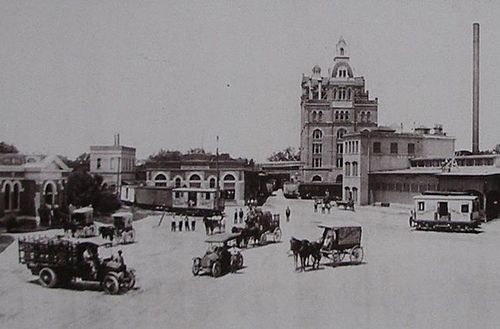|
|
The
people who settled Texas were thirsty. They were thirsty when they
got here and they have stayed thirsty. Since most of them came from
Europe, they were thirsty for beer as much - or more - than anything
else. In its absence, they resorted to concoctions like potato beer
and persimmon beer but soon recognized in themselves a preference
for beer that actually tasted, you know, good.
Beer has a long history in Europe, sparking a "chicken-or-the-egg"
type debate between beer and bread over which one came first. Science
is split on the issue, but beer drinkers are certain the world's
first accidentally-brewed beer tasted better than the first accidently-baked
piece of bread.
"Beer is proof that God loves us and wants us to be happy," Ben
Franklin wrote, and we note that Ben was no stranger to ale houses
of the day, a trait he shared with many of his fellow founding fathers.
Early day beer drinkers in Texas drank local beer from local brewers.
At first they drank ales, the beer of Shakespeare and Queen Elizabeth
and the oldest kind of beer in the world. Ale is brewed with top-fermenting
yeast that works best at warm temperatures. Detractors call it "that
warm British beer."
Ancient Egyptians drank ale. The Vikings - as we might expect -guzzled
the stuff, and the Pilgrims brought ale with them to America via
the Mayflower. Germans and Czechs started arriving in Texas in large
numbers in the 1840s with their own ideas about beer. They preferred
lager beer, which is cold-brewed from yeast that ferments near the
bottom of the tank. About 95 percent of the beer sold today is lager.
Thank the Germans and Czechs.
But lager presented a problem for early day brewers in heat-brutal
Texas - spoilage. To compensate, the first Texas home brewers usually
brewed their beer in the winter months and stored it in cellars
or even caves to keep it cool. The cellar at the Menger
Hotel in downtown San
Antonio was originally used to store beer from William Menger's
brewery, which he built in 1855. The hotel, which is still in operation,
came four years later.
Five years before Menger started his brewery, the 1850 census listed
19 brewers and distillers in Texas, according the Texas State Historical
Commission, but the 1850 manufacturing schedule didn't list any,
suggesting these were all home brewers. By 1860, Texas had 11 breweries,
a number that swelled to 44 by 1875.
The
brewing industry in Texas really began in 1883, when German brewer
Adolphus Busch and a group of local businessmen built the original
Lone Star Brewery in San
Antonio, a mechanized, large-scale operation that enabled Busch
to sell more beer at a cheaper price and transport it on wagons
over longer distances. That brewery lasted until Prohibition, but
another San Antonio
brewer took up the name Lone Star in 1940 and that's the
one that bills itself today as the "National Beer of Texas."
In the meantime, the San Antonio Brewing Association bought a small
local brewery and launched its own lager and bought its brand name
from a brewer in Germany who mused that the bubbles in beer resemble
tiny "perlen" or pearls. In such a manner was Pearl Beer
born in 1886. By 1916, Pearl was turning out 110,000 barrels a year
and was the best-selling beer in Texas by a wide margin.
|
 |
Pearl Brewery
in 1910. (Staats Collection)
Click on image for panoramic
view
'Notice all three modes of beer transport are shown: train, horse
drawn wagon, and delivery truck."
Wikipedia |
|
Otto Koehler
managed the Pearl brewery until his death in 1914, when his wife,
Emma, took over and kept the brewery solvent even as various temperance
and anti-saloon leagues lobbied to shut down breweries and saloons
across the country, an effort that culminated in Prohibition. Emma
kept Pearl going through Prohibition by selling ice, dairy products
and soft drinks. And maybe a little beer.
When Prohibition ended one minute after midnight on September 15,
1933, Emma started dispatching beer to the thirsty Texas masses.
By the 1950s, Pearl and Lone Star battled it out for the loyalties
and dollars of Texans as they expanded their respected brands to
other states.
The other 20th century brewery of note is the Spoetzel Brewery
in Shiner,
maker of Shiner beer. A group of thirsty locals there created a
beer co-op called the Shiner Brewing Association, but they had trouble
making beer and an even harder time preserving it. Kasmas (Kosmos)
Spoetzel, a Bavarian native and brewmaster, answered an ad in a
San Antonio newspaper
for someone to lease the little brewery in Shiner in 1914, then
exercised an option to buy it in 1915. Spoetzel's daughter took
over the operation after her father's death in 1950.
The
latter half of the 20th century saw major breweries like Anheuser-Busch
and Miller set up shop in the state as most of the long-time
local breweries sold out or went out of business. The Pearl Brewery
closed in 2001, but the old building is still one of downtown's
most iconic and recognizable structures. Today, the Miller Brewing
Company produces both Peal and Lone Star beers.
The Spoetzel Brewing Company, now owned by Gambrinus Company
of San Antonio, still
produces the beer that made it famous, and dozens of other varieties
as well. It's the fifth largest craft brewery in the U.S. and the
10th largest brewery of any kind.
Speaking of craft brewers, Texas has hundreds of them now, mostly
in the San Antonio,
Austin, Dallas-Fort
Worth and Houston
areas. For the most part, they're local breweries making their products
for local people, same as it was in the early days. That's as it
should be. Texans are still thirsty.
© Clay Coppedge
"Letters from Central Texas"
July 2, 2017 column
|
|
|
